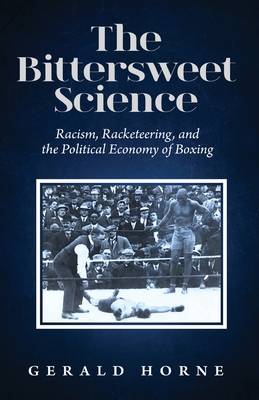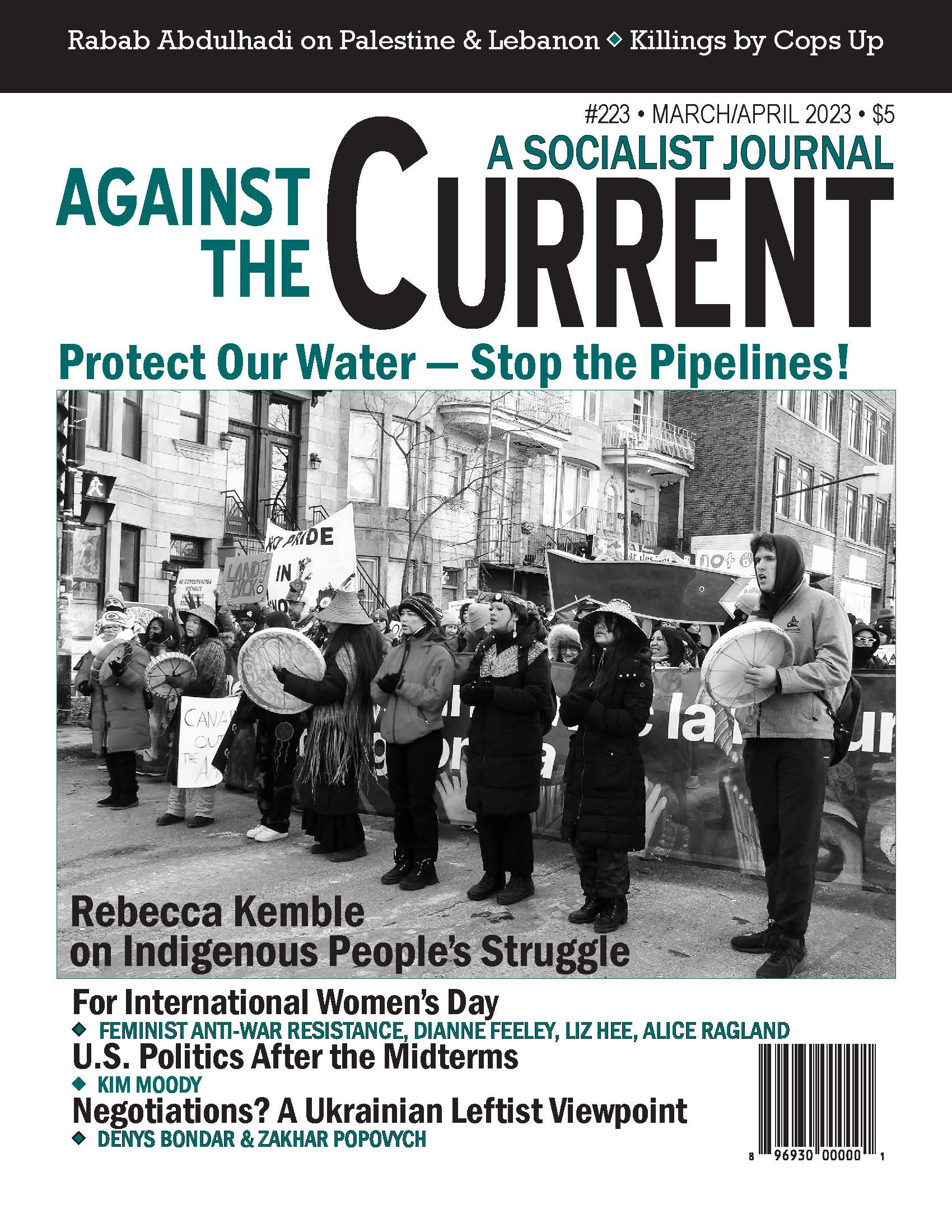Against the Current, No. 223, March/April 2023
-
Women's Rights, Human Rights
— The Editors -
Lives Yes, Pipelines No!
— Rebecca Kemble - Salvadoran Water Defenders
-
Killings by Police Rose in 2022
— Malik Miah -
View from the Ukrainian Left
— Denys Bondar and Zakhar Popovych -
Witness, Resilience, Accountability
— interview with Rabab Abdulhadi - Palestine Solidarity Activism Under Fire
- The Horror in Occupied Palestine
-
Nicaraguan Political Prisoners Freed, Deported
— Dianne Feeley and David Finkel -
Stuck in the Mud, Sinking to the Right: 2022 Midterm Elections
— Kim Moody -
Heading for the Ditch?
— David Finkel -
Paths to Rediscovering Universities
— Harvey J. Graff - International Women's Day, 2023
-
Demanding Abortion Rights in Russia
— Feminist Anti-War Resistance/ FAS (Russia) -
Before & After Roe: Scary Times, Then & Now
— Dianne Feeley -
Abolition. Feminism. Now.
— Alice Ragland -
#Adoption Is Trauma AND Violence
— Liz Hee - Reviews
-
Radical Memory and Mike Davis' Final Work
— Alexander Billet -
A Revolutionary's Story
— Folko Mueller -
James P. Cannon, Life and Legacy
— Paul Le Blanc -
The World of Professional Boxing
— John Woodford -
A Powerful Legacy of Struggle
— Jake Ehrlich -
War and an Irish Town
— Joan McKiernan - In Memoriam
-
Mike Rubin 1944-2022
— Jack Gerson
John Woodford
The Bittersweet Science:
Racism, Racketeering and the Political Economy of Boxing
By Gerald Horne
International Publishers, 2021, 329 pages, $15 paperback.

THERE ARE FEW people on earth better qualified than this reviewer to assess Gerald Horne’s fact-jammed examination of the U.S. boxing industry and a few of its foreign tributaries.
That’s not bragging. It’s more of a confession that I’ve seen at least ninety-five percent of the televised boxing matches from the dawn of TV on, and most of the contests I’ve missed were pay-per-view specials that were not rebroadcast free.
My father and his brothers and sisters were all fight fans, so as early TV broadcasts expanded from Friday Night Fights to Wednesday and then even Monday Night Fights, I had plenty of family company throughout the ’50s.
The rise of heavyweight king Joe Louis, the Brown Bomber, had spurred our addiction for the sport, as it had for millions of Black Americans.
I remember weeping as I listened to the radio broadcast of Rocky Marciano knocking out an aged and broke Joe Louis in October 1951, when Joe was well past his prime and in need of a payday to meet federal tax bills.
Boxing had been televised for only two years then, having debuted in January 1949 in Chicago, right across Lake Michigan from our home in Benton Harbor, Michigan. My father had films of most of Louis’s fights, and so I’d seen the champ often on our home screen.
One of my father’s friends in medical school at Howard University was the brother of John Henry Lewis, one of Joe’s “bum-of-the-month” opponents, whom Joe knocked out in January 1939. Furthermore, my father sometimes served as the fight physician for local amateur bouts, and I accompanied him at ringside on several occasions.
Years later I met not only Joe Louis himself, when he was in the early stages of dementia, but also his ex-wife Marva Spaulding and his son Joe Louis Barrow Jr., aka “Punchy,” and daughter Jacqueline Barrow. Louis greeted me, “Hey, you look just like my son Punchy.”
Blow by Blow
I say all this to advise the reader that if you are not similarly steeped in the glory and gore of this bloodsport, you will likely not go the distance with Horne’s blow-by-blow, round-by-round account of, as he puts it, the “racism, and profiteering, exploitation and corruption in the sport that is boxing.”
Horne, who holds the Moores Chair of History and African American Studies at the University of Houston, has meticulously documented those same forces and patterns in the U.S. film, aviation and music industries, as well as in organized labor struggles.
His almost three dozen other books range over the globe and deep into centuries of struggles for national liberation, social democracy and economic justice. The Bittersweet Science contains the results of Hornes’ combing of numerous archives, biographies, autobiographies and studies devoted to boxing.
He traces the early segregation and desegregation of the sport from the late 19th century on, highlighting the recurring rise and fall of Great White Hopes to demonstrate the manly traits once conceived to be embodied in boxing.
Horne follows the money throughout the book, acknowledging the financial opportunities, both the legalized and the downright criminal varieties — the latter being quite the larger force — that accompanied the sport from its beginning.
Following the Money
Crooks, politicians, journalists and regulators on state boards have cooperated with one another, and also ordered or condoned mayhem and murder of rivals, throughout boxing’s history.
They have done so, Horne shows, because boxing has enriched promoters and the cities and states where they operate. When city or state officials decide to clean up the sport, the promoters threaten to move their game elsewhere, and sometimes do, playing states, courts and municipalities against one another for the tax monies derived from the fighters’ labors.
Thus every major “crime family” pops up regularly in this volume because boxing “was just a part of the conglomerate that also controls many labor unions and related industries such as construction, shipping, garment, garbage disposal.”
All these “revenue streams” serve as laundering facilities for dirty money bubbling up out of the sewers swelled by our nation’s “casino magnates.”
Fixed fights; bribing of referees, judges and state boxing commissioners; “promoters” who conspire with one another to cheat the fighters they “own” under contracts they’ve devised; violent gangland methods familiar to anyone who’s seen movies about boxing methods — it’s all laid out here in unrelenting, if often confusing or tedious, detail.
In short, boxing provides Horne and his readers with another way to understand both the systemic, harmful operations of capitalism while also suggesting ways to mitigate, combat or overcome the damage.
In boxing’s case he recommends federal oversight, unionization of the workforce, safety measures such as requiring larger gloves and protective headgear, pension and health-care benefits, and strict taxing of boxing revenues to help pay for such measures.
I think Bittersweet Science> would have been a better book if Horne had marshaled his evidence and focused his argument on what measures reformers ought to take today. Perhaps the chapters could have been organized so as to address each of the problem areas requiring the reforms I’ve mentioned.
Problematic Sources
The book is somewhat of a data-dump, owing, I’d say, to Horne’s having been ill-served by his editors. Sloppy, misleading references and a dizzying jumping back-and-forth chronologically, not only from paragraph to paragraph but often within a paragraph, confound the reader hoping to make sense of this heavily narrated path through a complicated history.
In multiple places, the text tantalizes the fight buff with an assertion that can’t be traced to a source in the index or bibliography. In the chapter “Gangster’s Paradise” one reads of Joe Louis:
“He ‘inadvertently’ broke the leg of Lena Horne, the progressive chanteuse, which raised troubling problems about his ongoing problems with women.”
Where did that “inadvertently” come from? Where did the injury happen and under what circumstances?
The book offers no answers, and the reader is left to assume that it came from Library of Congress files covering the investigation of Black promoter Truman Gibson.
(Gibson wound up taking the rap in a 1961 federal corruption trial along with out-and-out gangsters who were his co-defendants. Gibson had been the front man in extensive TV boxing endeavors along with his Chicago “partners” James Norris and Arthur Wirtz, two billionaires who escaped prosecution. The lesson Horne draws from Gibson’s story, and several similar ones, is that even when Black people benefit from succeeding in criminal enterprises, and even if they donate some of their earnings to civil rights causes, when they get caught they’re still subject to more severe penalties than whites.)
Later, in a discussion of the State of New York’s efforts in 1974 to combat boxing corruption and protect fighters from avoidable injuries, Horne says:
“By 1974, Albany was facing a problem that had dogged the sport ever since it had attained a veneer of legality decades earlier. The august New York Times had editorialized in favor of banning the sport. Regulators argued that ‘during the three years prior to the enactment of the Walker Law which restored boxing legally in 1920, 35 ring deaths occurred’ at a time when ‘bouts were held clandestinely in barrooms and on barges and the bodies of boxers were found in the river, on hospital steps and in alleys.’”
What circumstances surrounded the Walker Law? I wondered. What did it say? The footnotes and index provide no information, and I can only guess that it had something to do with New York Mayor Jimmy Walker who, Horne mentioned 200 pages earlier “was reported” as “not allow[ing] a mixed bout in his bailiwick,” meaning a bout between Black and white fighters.
Heart of Darkness
Supplying fight fans with opportunities for quibbling and nit-picking, for wallowing in trivia, is no mean achievement in this day and age, when the sport again seems to be circling the drain. I’m grateful to Horne for providing us with many such opportunities.
Besides, the wonderful tidbits he offers, like the following about the “informal pugilist” Norman Mailer, more than make up for the irritations inflicted by the text.
It was October 1974, and the famed author was in the Democratic Republic of the Congo (then Zaire) to cover the “Rumble in the Jungle” between heavyweight champ George Foreman and Muhammad Ali, who would confound his bigger and stronger foe via his masochistic “rope-a-dope” defense, and then knock him out.
Mailer’s “journey to the heart of darkness apparently stirred darker impulses within him,” Horne writes, and he continues:
”This was during a time when the very term ‘Black Power’ seemed to spur a severe bout of angst among certain Euro-Americans, as if they were jolted back to the early days of settler colonialism, when they were perpetually besieged.
“Pretentiously referring to himself in the third person, the logorrheic Mailer — whose father had decamped to South Africa before arriving in the U.S. — revealed what he should have kept hidden: ‘he no longer knew whether he loved Blacks or secretly disliked them.’ His purpose in the Congo was ‘not only… to report on a fight but to look a little more into his own outsized feelings of love and — could it be? — sheer hate for the existence of Black[s] on earth.”
Gerald Horne finds many a gem in his secondary sources, and when he does, he always knows how to mount it just right.
March-April 2023, ATC 223

